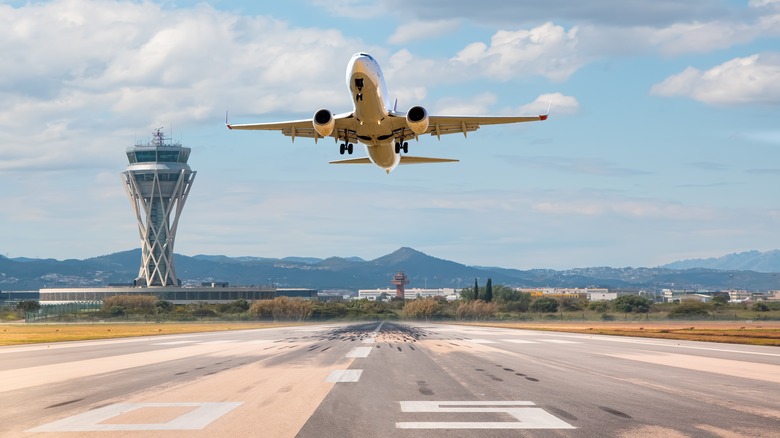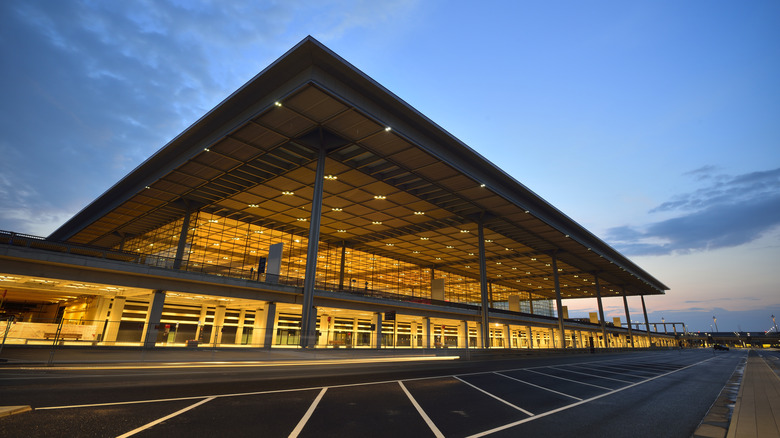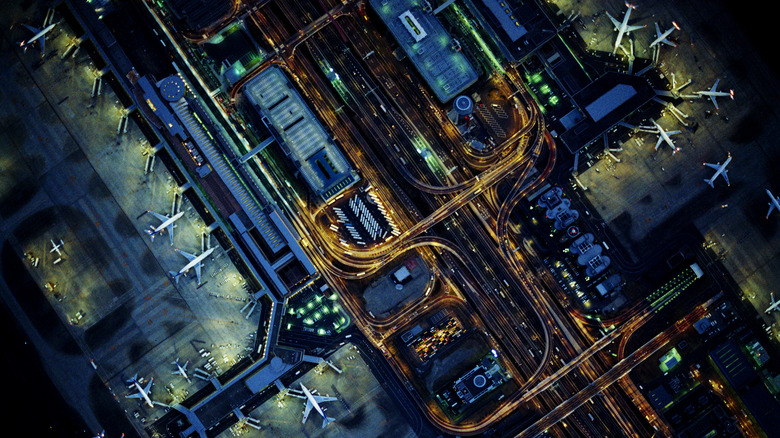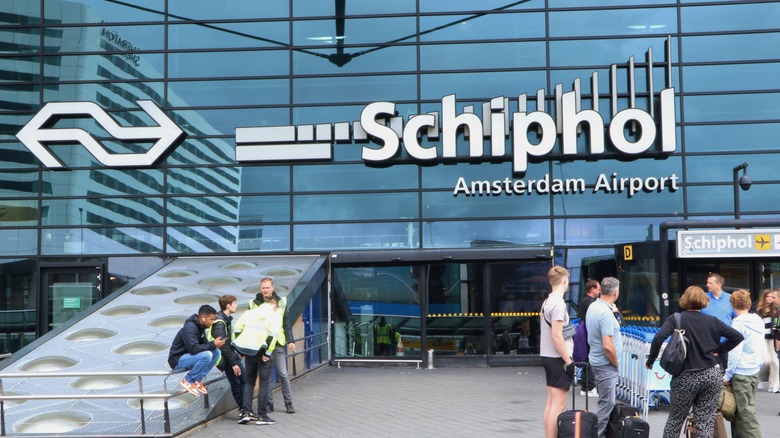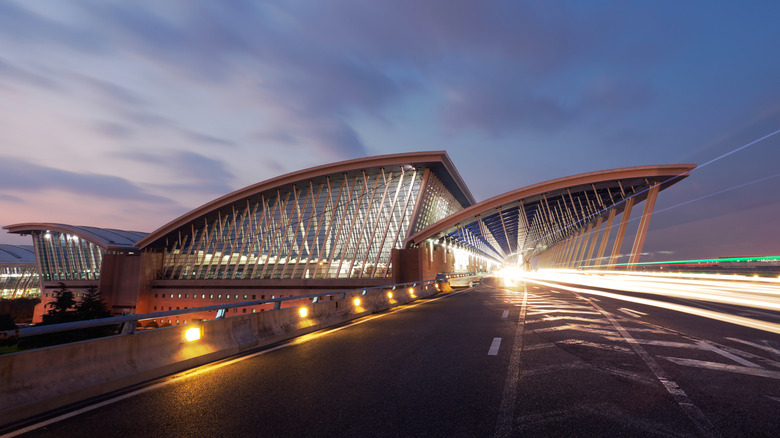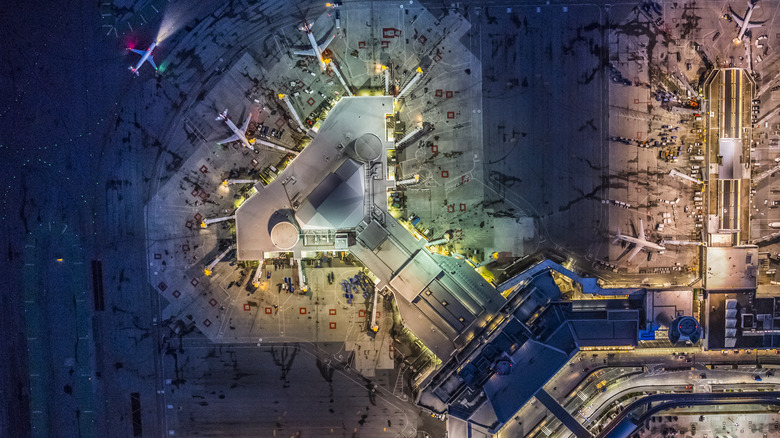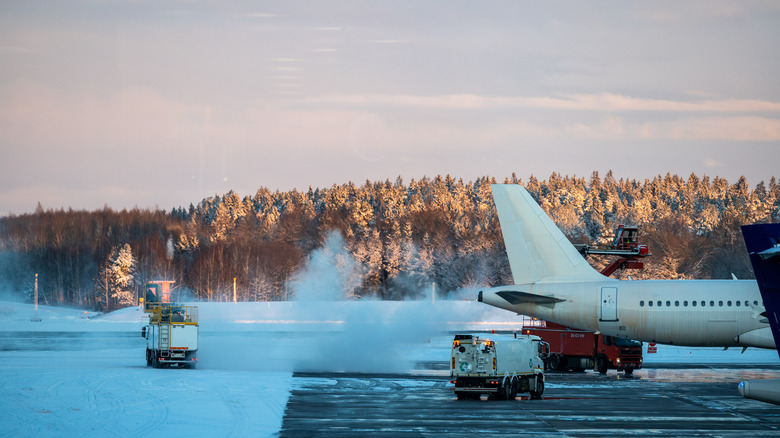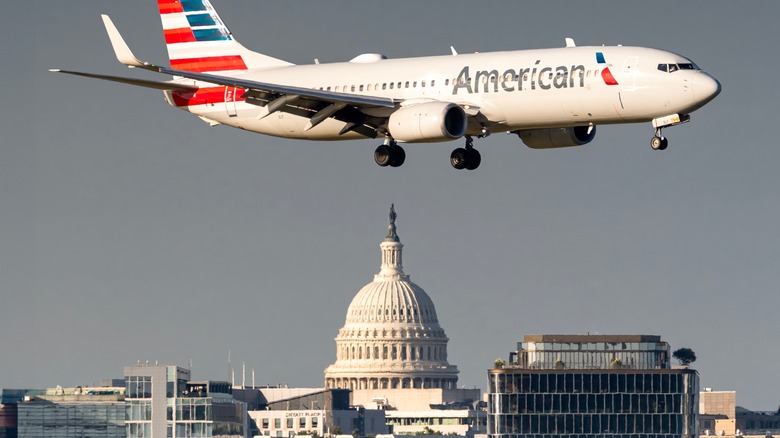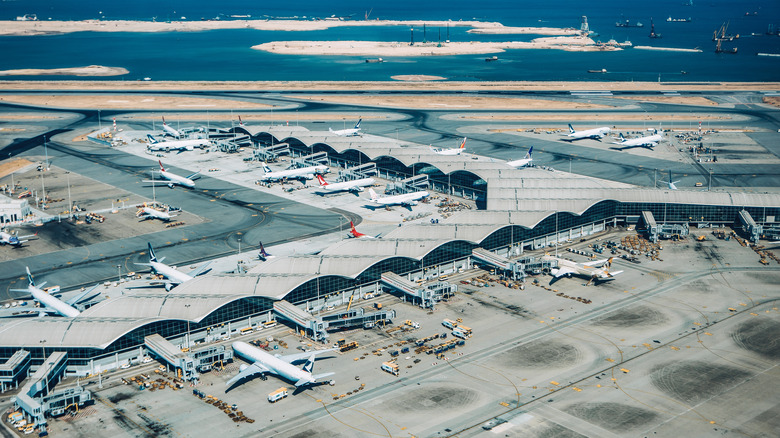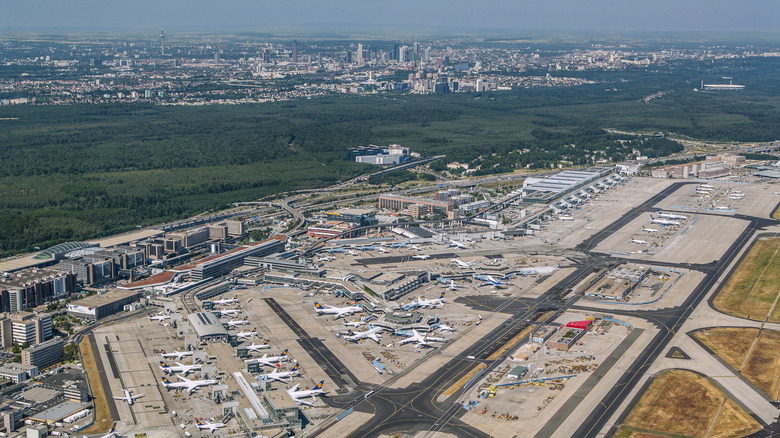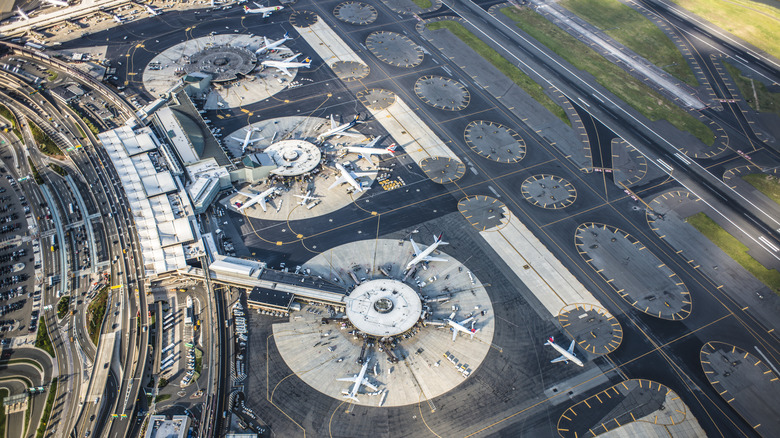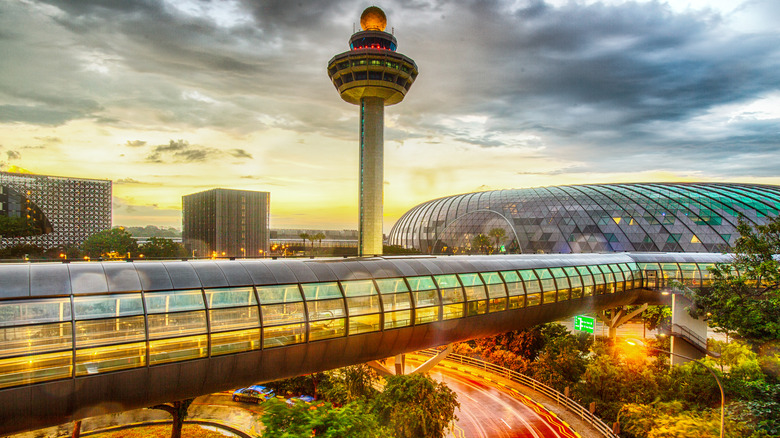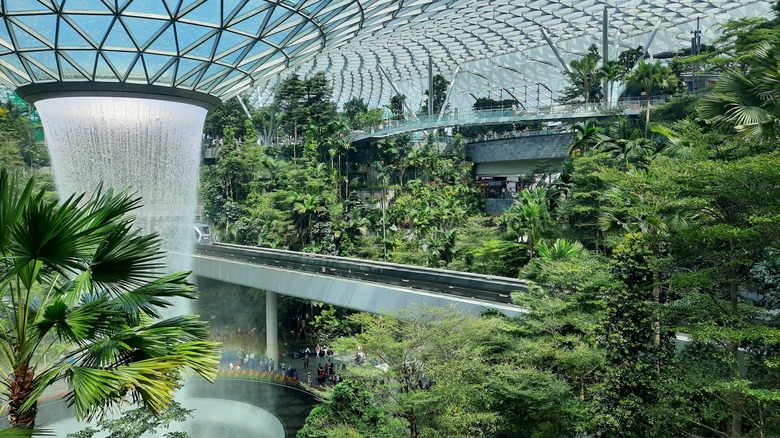Airports Around The World With Great Public Transportation Options
Landing in an exciting new destination is the stuff of dreams for many afflicted with the travel bug. Whether you're an explorer seeking adventures in Asian capitals, on the hunt for exquisite food delicacies that aren't part of your hometown's general fare, or a culture hound on a mission to discover the sights and sounds of your heritage in Africa (a truly magnetic continent of diverse voices brimming with dynamic cultural marvels), Europe, or South America, flying is only half the conversation. Booking flights while seeking out great pricing has a bit of a knack to it, but making your way from the airport and into the city is entirely different. You won't really have any control over the transition from travel hub to bustling city center and must instead rely on the existing infrastructure found in your destination.
Plenty of magnificent public transportation systems exist throughout the world, with some of the best found in East Asian capitals and Western Europe, in particular. American travelers might not be entirely confident getting on a bus or rail line due to a lack of exposure to fast, efficient, and often cheap public options. But people elsewhere in the world do enjoy amazing transportation options that allow them to leave the car at home or skip out on ownership of a personal vehicle altogether. Even so, there are a few cities in the United States that benefit from well-connected public mobility options to and from the airport. When planning your next trip away, consider one of these destinations to experience the magic of truly wonderful public transit choices to and from the airport (and in the city itself in many cases).
Berlin Brandenburg Airport, Germany
Berlin is a great place to begin, both for visitors coming to the city and those seeking day trips while using it as a starting point. The German capital is immensely well connected, with 175 stations dotting the city map and nine lines coming together to connect them all. Berlin's air transit hub is just outside the city itself in the nearby Brandenburg state (roughly 15 miles from the city center). It's about a half-hour drive from the airport, but there's no need to get into a taxi or hire a car for this short voyage from the airport. Instead, travelers flying into Berlin can take either the Airport Express (FEX) or regional trains that run multiple times every hour. The S9 and S45 trains are part of the S-Bahn network and run every 20 minutes into the city. Travelers can also take the Intercity BER T1-2 to connect to other regional cities like Dresden/Chemnitz and Rostock.
A bevy of regional trains also bring commuters into and out of the city (RE8, RB23, RB32, and others), as well as three buses, with the X7 departing every five to ten minutes and taking passengers to the nearby Rudow U-Bahn station to facilitate additional onward travel. The network might feel daunting at first, but it's easy to get the hang of these train lines and their connected destinations for anyone who fancies themselves as a map reader. Berlin is a magical city, and its public transportation network makes it all the more enjoyable for visitors.
Haneda Airport (Tokyo International Airport), Japan
Tokyo is another city that sports a sprawling public transportation network. From buses to subway rail, Tokyo feels very much like a high-density collection of towns rather than the massive urban city it truly is. Tokyo is a city that prides itself on efficiency, however, and more than 14 billion total yearly riders is a figure that attests dramatically to this aim. From bullet trains to local commuter rail lines, Tokyo features a vast network of public transportation options that can bring visitors and locals around the community in a hurry. Tokyo's public network can seem a bit daunting to first-time users, but maps located in stations and paper copies that can be taken away with you help illuminate the system and make things easier to manage.
Haneda Airport is often referred to as Haneda-Tokyo or Tokyo International Airport because it's the closest major airport to the city. Haneda is just a short hop south of the city, while Narita (Tokyo's other large air travel hub) is about 50 miles east. Moving from terminal to town is simple on either the Keikyū Line or Tokyo Monorail. These train options take around 20 minutes maximum to deliver you into the city and run throughout nearly the entire day, departing every few minutes (as few as three minutes between departures and up to 14 minutes during slower times) on the monorail and five to 10 minutes on the Keikyū Line. Both continue operating from around 5 a.m. to just before midnight every day. Travelers arriving into Haneda can also get on buses that depart constantly from the arrivals hall and bring people to numerous destinations throughout the city (potentially a better option for some, depending on where they might be staying).
Amsterdam Airport Schiphol, Netherlands
Not only is Amsterdam Airport Schiphol one of the oldest continuously operating airports in the world, but it's also amazingly well connected to the major city it serves. Amsterdam is immensely accessible to the rest of the Netherlands by rail, and this includes the tram lines that crisscross their way through the city's canal-lined streets. The Dutch capital is a major travel hub, greeting Delta and others in the SkyTeam Airline Alliance ((SkyTeam's headquarters are in Amsterdam). This makes it a transit hub that many American travelers are likely to fly through on their way across Europe or beyond, even if Amsterdam isn't the final destination.
As a wonderfully rich community full of history, culture, and beautiful architecture, Amsterdam is a place many want to visit and a solid choice for a long layover. Because the airport is so easy to access, making your way into town for the afternoon before hopping back into the terminal to board your next flight is entirely within reason. A train journey from the airport to the city center takes less than 20 minutes and costs just over $5 (4.90 euros). The train terminal is located directly under the airport's arrivals hall, so getting onto the tracks and boarding a train is incredibly easy. Between 5:30 a.m. and midnight, trains run every ten minutes at the slowest (with certain times seeing departures every four). Between 2 a.m. and 5 a.m., you may need to time your journey a little more diligently with hourly departures. You can tap your contactless payment card (or your phone's payment app) to buy a ticket with ease before heading on your way into town.
Shanghai Pudong International Airport, China
As a former resident of the world's most populous city, personal knowledge of Shanghai's metro system and transit options to and from the airport certainly color my opinion. The subway system is one of the best around, with high-speed trains whisking commuters through the sprawling metropolis at a bristling pace, and for just a few cents per ride (3 kuai — the colloquial name for Chinese currency — is typical for a standard journey and converts to about 40 cents). Trains are frequent and move quickly, darting from station to station in just a minute or two on many lines.
The city is well-served by the metro and sprawling network of bus lines, to be sure, but the airport also features a dramatically efficient mode of transportation to and from the city. The Maglev train reaches a top speed of 267 mph and rockets passengers along a raised track from the city out to Pudong's airport terminals in just eight minutes (over a 19-mile journey). Trains run every 15 or 20 minutes on two side-by-side tracks. They hurtle past each other on a straightaway at the midpoint and let out a grunting wave of air pressure that adds to the experience. The Maglev train lets out at Longyang Road Station (a walk across a pedestrian street from one another that features bubble tea stands, a McDonald's, and more). The station connects to Lines 2,7, and 16 for onward travel toward a variety of citywide destinations. Pudong is farther away from the city than Hongqiao International Airport, but with far greater passenger volume and the Maglev in its corner, Pudong is amazingly well situated to serve travelers coming into and out of Shanghai.
San Francisco International Airport, USA
It's true that most of the best-connected cities and their airports exist outside the United States, but this doesn't mean that no American airports make the list (or that travelers in the U.S. are simply resigned to a traveling life of inconvenience). San Francisco International Airport is a great example of how an American air travel facility and its community get things right. The Bay Area Rapid Transit system (BART) connects the entirety of the San Francisco Bay area with five lines that link Oakland and San Francisco together, along with their extended communities to the north and south (and farther east on the yellow and blue lines). San Francisco International is naturally lined into this network, with both yellow and red trains delivering passengers to and from the city just a hop to the north.
Heading across the bay is perhaps the easiest movement in the system, with four of the five lines (all but orange) connecting the San Francisco side of the bay to its eastern neighbor. Moreover, a journey from central San Francisco (beginning at Embarcadero) to the airport costs $10 and takes 34 minutes. This gives travelers a fast transfer from airport to city and back again for maximum fun while adventuring in this amazing west coast destination.
Stockholm Arlanda Airport, Sweden
Stockholm Arlanda Airport is the Swedish capital's primary air travel hub. It's about 25 miles from the city center and takes roughly 30 minutes to drive. However, the time is halved when hopping on public transportation. The city supports a vibrant network of busses, trams, subway lines, and national rail connections, making it a highly connected urban community with gorgeous natural scenery outside the metro center just a quick voyage away. Since 2017, the trains and buses in the network have all run on renewable energy sources, making the city a hub of green-focused transportation, too!
From the airport, the Arlanda Express gets you to the city's center in just 18 minutes. The train is fast, convenient, and costs about $30 for an adult, one-way ticket. Trains leave roughly every 15 minutes, so there are no worries about waiting for the next one if you miss the earliest departure possible after your flight's arrival. Buses are also available from the airport to the city and take around 45 minutes to complete the journey.
Ronald Reagan Washington-National Airport, USA
Unlike Dulles, farther away and deeper into northern Virginia, Ronald Reagan Washington-National Airport is right on the Potomac and links directly to the D.C. area metro system. The airport more adequately serves the D.C. metropolitan area, sitting right across the river from the nation's capital. It's the preeminent option for travelers looking to hop on the city's public transportation network and head right into town. On the yellow line, travelers are just four stops away from the National Mall and four from Arlington National Cemetery on the blue line. D.C. is a common destination for travelers seeking to explore the history of the nation.
The D.C. area airports are also a common stopover option on the way to American and international destinations. The Silver Line has finally extended all the way out to connect Dulles International to the city, as well, but a journey into D.C. from the decidedly more remote airport takes around an hour to reach Rosslyn station (across the river from Georgetown in the city's northwestern corner). Even with this option on the table, Reagan International offers easier access to the wonderfully historic city. Whether you're a visitor exploring the capital on an extended trip or a traveler looking to get out of the airport to explore the open-air national park experience that is Washington, D.C., this is the best choice if you can be selective.
Hong Kong International Airport, Hong Kong
Hong Kong is a sprawling territory sitting on the southern tip of the Chinese landscape and is its own quasi-administrative state, although politics surrounding the bleed over between its status in relation to China is a fraught topic. Hong Kong is one of the most bustling urban centers in all of Asia. It's the fourth most densely populated city in the world, and National Geographic calls it "exuberantly complex," and "a city of curiosities." Hong Kong is a place that every traveler looking to see the world will surely have firmly entrenched on their bucket list.
The community's metro system is one of its greatest strengths as a travel destination. 75% of the city's population lives within a 15-minute walk of a station, allowing rapid transit through the whole of Hong Kong for the vast majority of its residents. This makes sightseeing a breeze, too. With so much of the island community's landscape wired into the network, so to speak, plenty of great tourist destinations are easily accessible. Getting to and from the airport is equally simple. The Airport Express train leaves roughly every ten minutes throughout the day and takes just 24 minutes to arrive in the city. From there, onward travel is simple with the help of one of the world's best public transport systems.
Frankfurt International Airport, Germany
Frankfurt International Airport is a wildly connected hub for air travel, and those moving through its terminal halls can connect to 293 unique destinations onboard one of 81 airline selections. Frankfurt is the busiest airport in Germany, and its local community is a thriving and vibrant spot for explorers visiting the nation to get out and take in the culture. Frankfurt plays host to a plethora of museums and art galleries and is also considered the financial capital of Germany. The architecture here is naturally stunning, and the food scene is absolutely worth a visit.
Arriving in town from the airport is simple. From there, getting on the U-Bahn or S-Bahn will bring you all around the city with ease. There are seven trains that stop at Frankfurt Airport, allowing travelers landing in the city to quickly move from terminal to town. The schedule is totally packed, so even if you miss the first train, another is sure to follow closely behind, with just a few minutes between departures heading toward the city.
Newark Liberty International Airport, USA
Unfortunately, Newark is consistently ranked among airports with the highest volume of TSA complaints and stress-inducing travel hubs. Newark Liberty International Airport is a massive hub and serves both domestic connections and international travel, yet it often takes the brunt of customer satisfaction scores. Even so, the value that Newark provides to travelers is undeniable. The airport serves 183 destinations across every continent except Australia (and Antarctica, of course). Flights are coming and going throughout every hour of the day, and travelers routinely use EWR to access New York City across the Hudson River.
The NJ Transit and Amtrak trains that run between Newark International and New York City run constantly and demand less than half an hour of your time to complete the journey. Trains run throughout the day, with at least six NJ Transit trains arriving at the airport station every hour (and four between 9 p.m. and midnight). Amtrak routes also bring passengers to Philadelphia in just 70 minutes and beyond to destinations like New Haven and Boston. Flying into Newark affords travelers a convenient alternative to waiting in the terminal halls for a connection to regional destinations and can spice up your trip with a train journey, especially with a winter train journey!
Singapore Changi Airport, Singapore
Singapore is quite like Hong Kong in that the country and city are closely intertwined. But in Singapore, the country's boundary is essentially just the small island landscape separated by narrow shoals from Malaysia. The city expands to command nearly the vast majority of the primary island, and the country covers an area of just 283.5 square miles.
The airport is located in Singapore's Changi district along the far eastern extent of the island, but meandering from the airport to central Singapore City is easy and quick. A taxi can bring you directly to your hotel and costs between 20 and 40 Singapore Dollars ($15 to $30) on a metered fare basis. Taxis into the city take about 30 minutes, while a bus journey takes about an hour and costs S$2 (about a dollar-fifty). There's also a free bus service running from 11:30 a.m. to 2:30 a.m. during the week. The MRT connects virtually the entire city, and visitors can purchase a Singapore Tourist Pass to cover all their travel on the network. It links in with the airport, making for another convenient option when visiting the city-state.
Methodology
The cities and their airports listed were selected based on ratings of the communities' public transportation throughout their metro areas. In addition to interconnectedness within the cities themselves, public transportation options were required to and from the airport. Many of these airports feature a plethora of transportation options for travelers looking for the right method for their needs. I have personally flown to or from eight of the 11 airports highlighted and can personally attest to the ease of access that a great many of them offer.
